The Schøyen Case: How the Western Hegemony Still Upholds
Like return claims in other Western countries, the Schøyen Collection case in Norway illustrates how viewpoints from the past still hold sway. With...
Guest Profile 18 July 2023
The elusive Etruscans left behind a rich legacy of gold craftsmanship that was among the most advanced in the ancient Mediterranean world. While the techniques applied by Etruscan goldsmiths and jewelry-makers, as well as the iconographic motifs depicted on the jewelry, had much older, foreign origins, there remains no doubt of the great artistic strides and refinement achieved in the Mediterranean basin around 700 BCE onwards. The study of the gold jewelry of Etruria is fragmentary as it is studied primarily from tomb excavations.
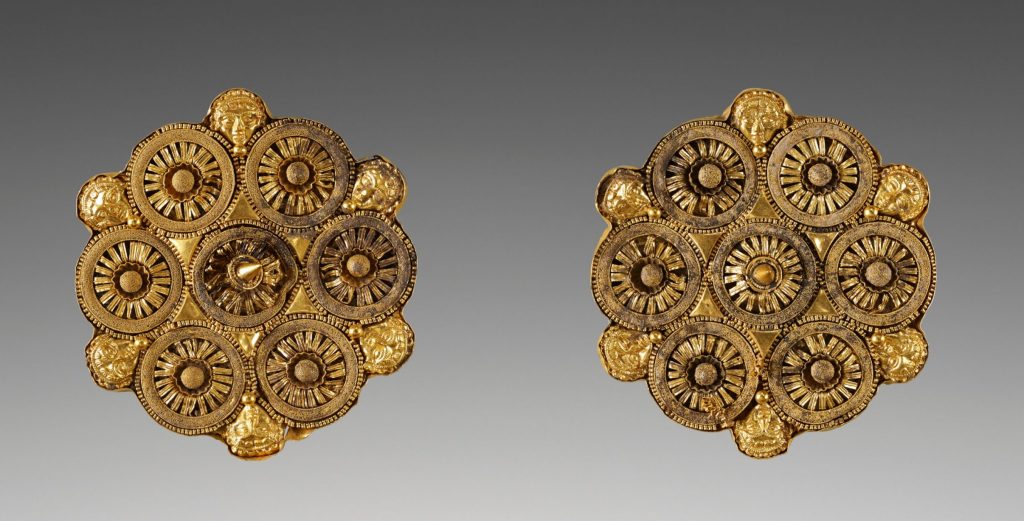
Gold pair of disk ear studs, ca. 525–500 BCE, Getty Villa, Los Angeles County Museum of Art, Los Angeles, CA, USA.
The Etruscans were among the many inhabitants of early Italy, and their origins remain a topic of debate among academics. While some believe they were native to Italy, the prevailing theory maintains that the Etruscans were colonists from Anatolia (modern-day Turkey) that succeeded the Villanovan culture of the Iron Age. While the Anatolian roots theory has been supported by genetic research, it is interesting to note that their language bore no relation to the languages spoken in Turkey. The Etruscans left behind a legacy of masterful building styles and techniques in early Italy that were later adopted by the great Roman builders who succeeded them.
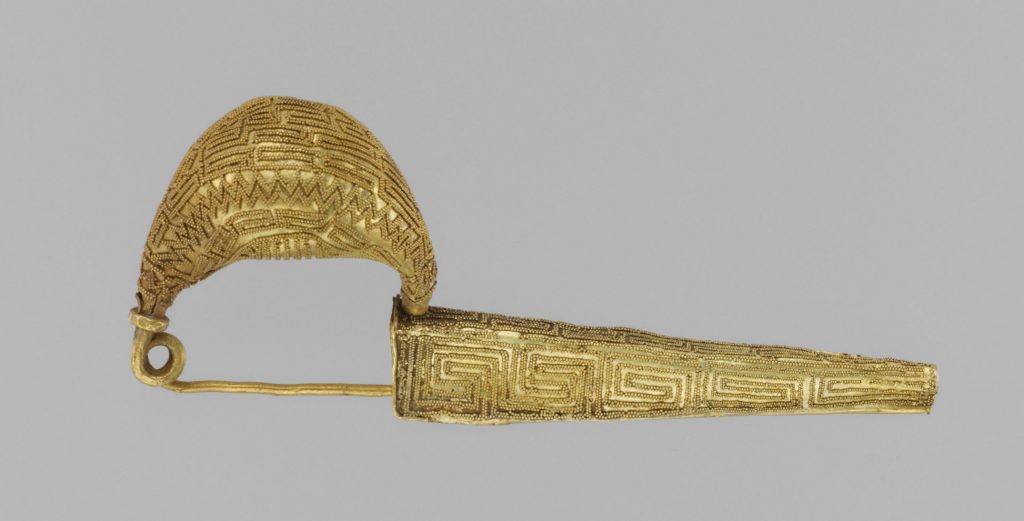
Gold sanguisuga-type fibula (safety pin) with patterns in granulation. ca. 700 BCE to 601 BCE, The Metropolitan Museum of Art, New York, NY, USA.
The economic growth of the Etruscans is attributed to their flourishing agriculture and vast deposits of copper and iron in the northern region. This in turn contributed to a highly sophisticated trading system as early as 700 BCE. Etruria developed fiscal and cultural ties with its neighbors in the broader ancient Mediterranean region. The Etruscan traditions and techniques in gold foraging were largely a result of the foreign influence from trade routes.
The metallurgical techniques of the Etruscan goldsmiths drew on Egyptian, Near Eastern, and Central European metalwork, and techniques such as granulation, filigree, and repoussé were adopted by Etruscan jewelers. Geometric patterns common to Near Eastern design are featured regularly in Etruscan jewelry, such as the reoccurring disk earrings inspired by the Lydian style. Palms, pomegranates, acorns, griffiths, etc. were a recurrent motif that hinted at Greek, Egyptian, and other Near Eastern influences.
Foreign trade revolutionized the gold industry, particularly in the southern region where the designs were sophisticated and flamboyant. Syro-Phoenician and other foreign jewelers who settled along the southern regions of Etruria and instructed local apprentices in their techniques and designs. The finest Etruscan jewelry was crafted in city-states such as Cerveteri, Tarquinia, and Vetulonia.
Although copper and iron deposits were plentiful in Etruria, gold was relatively scarce. The Etruscans therefore valued and refined light and precise workmanship and goldsmiths hammered the metal into thin sheets, generally less than 0.1 mm thick. Thicker jewelry designs were forged with rolled-up sheets with hollow centers to extend available resources.
The basic forms were then ornamented, and the most prevalent techniques of ornamentation were repoussé which involved creating a raised relief by embossing, granulation where tiny globules of gold were carefully fastened onto the basic forms with a heated point, and filigree where minute threads of gold were manipulated into intricate decorative motifs. Gemstones were frequently woven into the jewelry.
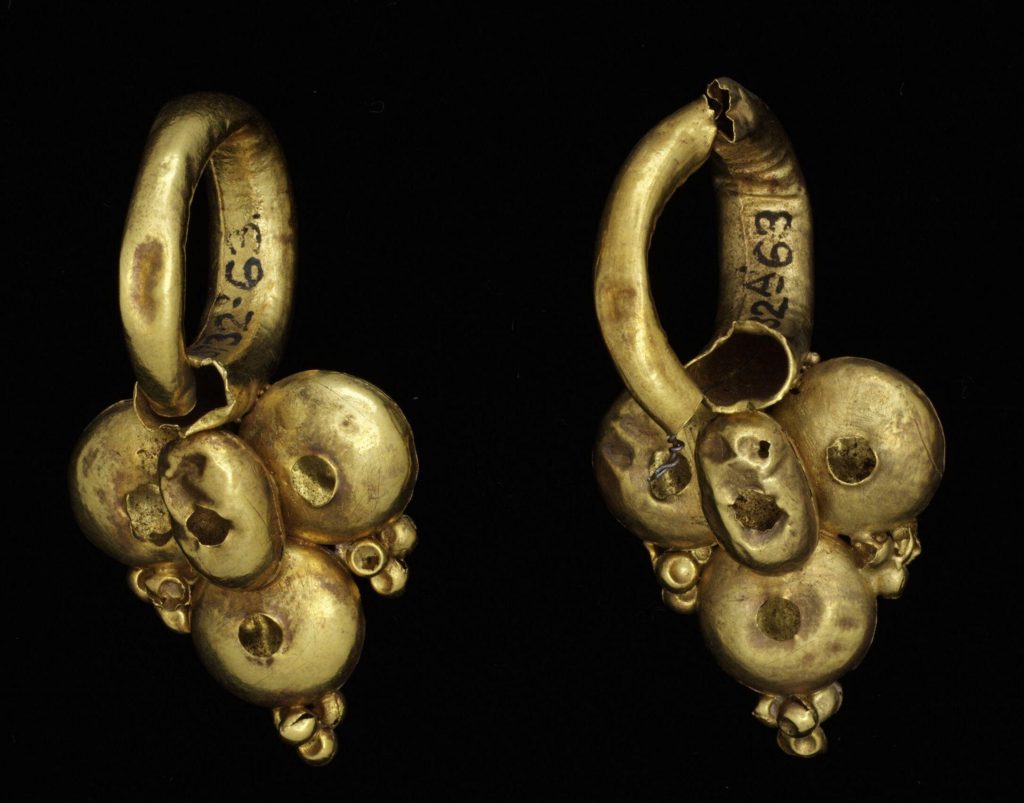
Gold earrings with granulation design, ca. 400 BCE to 300 BCE, Victoria & Albert Museum, London, UK.
Etruscan jewelry included both decorative adornments such as diadems and earrings, as well as functional items such as belts or fibulae (forms of brooch pins that served to fasten garments). 18-karat gold was greatly valued in jewelry-making due to its malleability.
Compared to their neighbors in Asia Minor or even the broader Near East, Etruscan men and women sported a wider range of ornaments (as observed in artworks of Etruria and the Mediterranean cultures), although it cannot be confirmed if it were a normal part of their costume or just an idealized artistic representation.
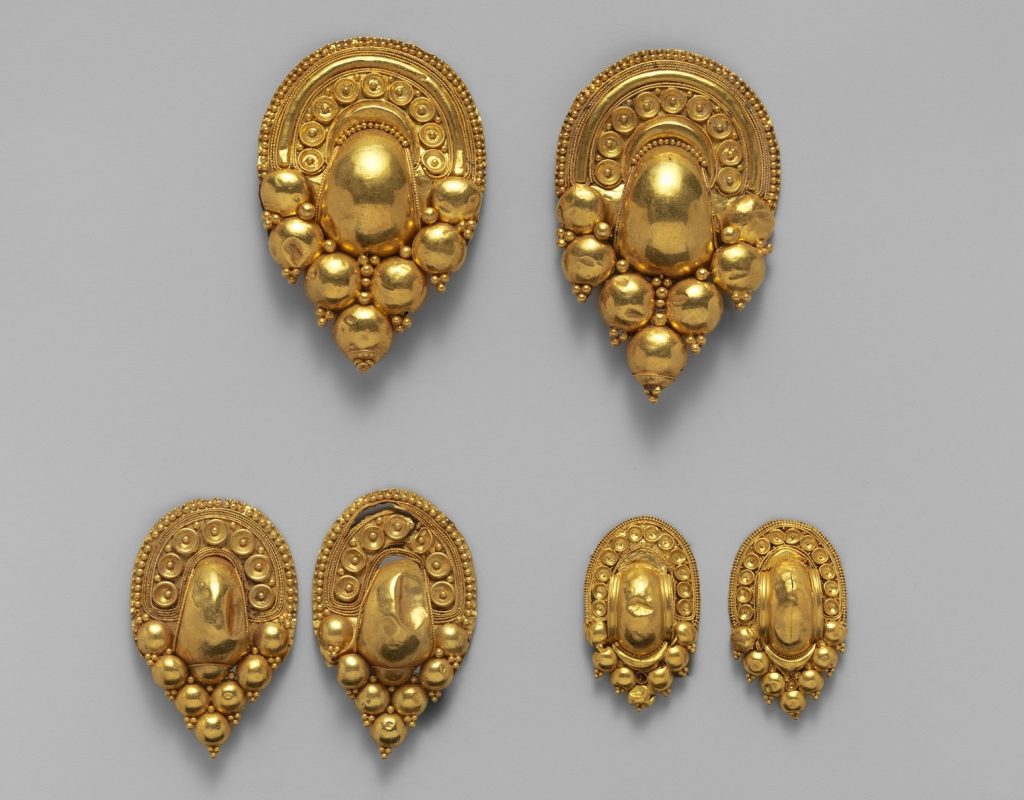
Gold grappolo style earrings, ca. 400 BCE to 201 BCE, The Metropolitan Museum of Art, New York, NY, USA.
Tomb paintings, pottery, and sculpture, as well as paintings, have evidenced the generous use of jewelry among men, women, and children in Etruria. However, adult women were likely the most prevalent patrons. It has been theorized that the application and placement of jewelry evolved over life stages, and therefore the placement of jewelry served as a means to understanding various aspects of life in Etruscan antiquity.
In 1896, Italian military general and archeologist, Vincenzo Galassi, and Alessandro Regolini, the archpriest of Cerveteri, discovered an intact Etruscan tomb in the Sorbo necropolis of ancient Caere (present-day Cerveteri, Italy) that became an important source in gaining a deeper understanding of the period. The Regolini-Galassi tomb revealed a significant quantity of gold and precious metals that hint at the elite social standing of its occupants. Since gold was precious and not so freely available in Etruria, it is possibly a significant gesture that it was removed from circulation to be buried with the deceased.
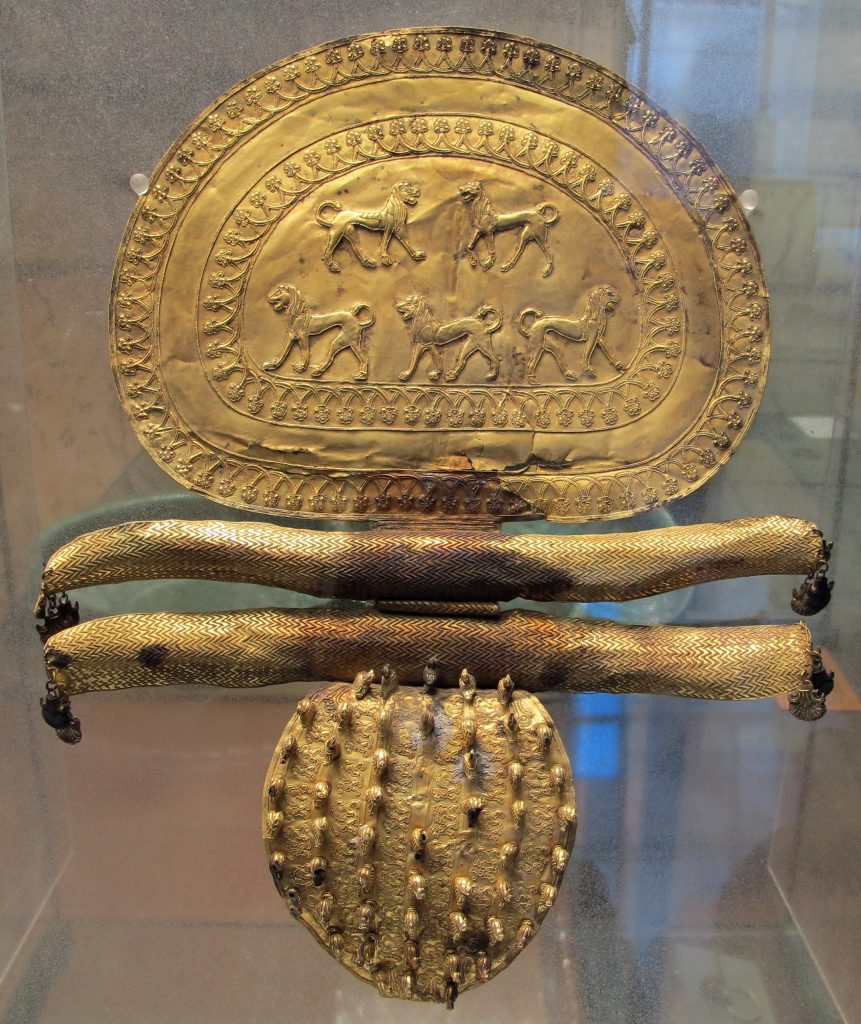
Gold fibula with disk from the Regolini-Galassi tomb, ca. 675 BCE to 650 BCE, Museo Gregoriano Etrusco, Vatican. Photograph by Sailko via Wikimedia Commons (CC-BY-SA-3.0).
Despite the significant wealth of information derived from the Regolini-Galassi tomb, it is important to note that funerary customs could have broader religious or social connotations they may not have been representative of real-life practices or even the economic status of the subjects as it is unlikely to be a true-cross section of Etruscan demography.
Although Etruscan jewelry leaves behind an inconclusive and fragmentary understanding of their society, there remains no doubt of the advanced skills of Etruscan goldsmiths that also serves as a remarkable testament to the interconnectedness of the ancient Mediterranean world.
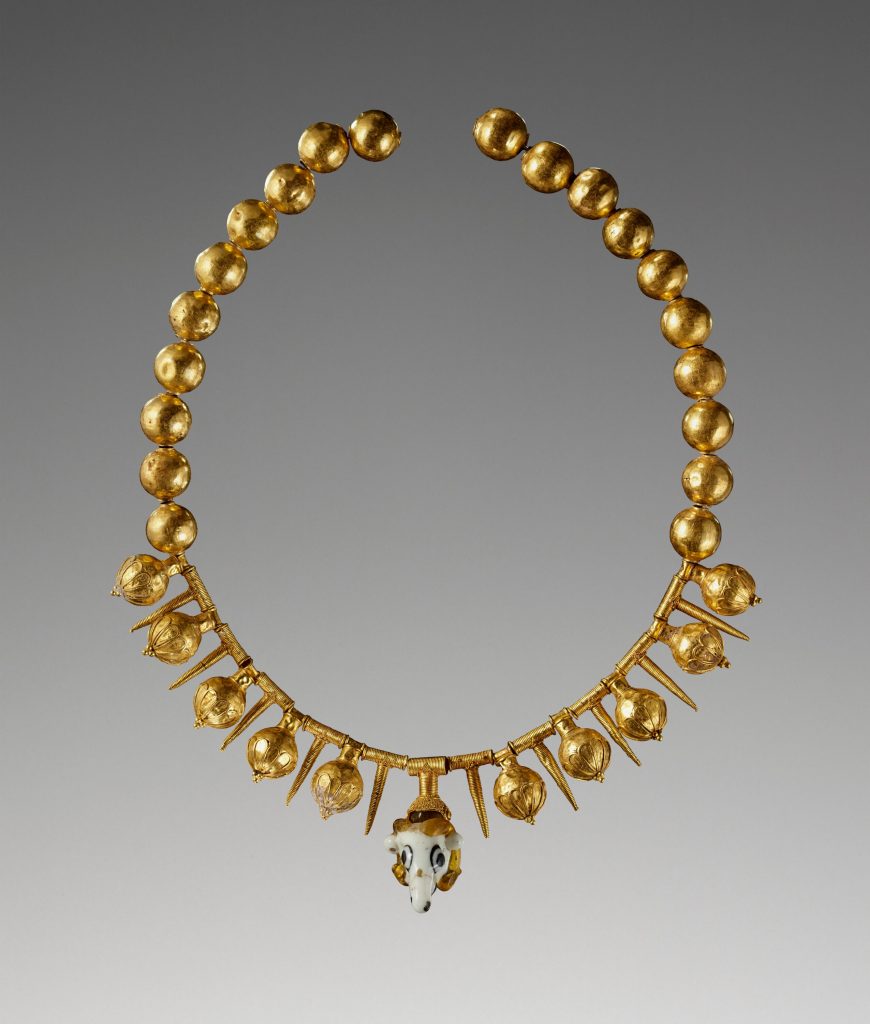
Gold necklace with Ram’s head pendant, ca. 500 BCE to 400 BCE, The Getty Villa, Los Angeles, CA, USA.
Aldo Castellani of Rome, A Memoir on the Jewellery of the Ancients: Etruscan Jewellrey. Accessed on 6 Nov 2022.
Barbara Deppert-Lippitz, Ancient Gold Jewelry at the Dallas Museum of Art (Dallas: Dallas Museum of Art in association with the University of Washington Press, 1996), 31-39. Accessed on 6 Nov 2022.
John Tuttle. “Etruscan Gold Jewelry” World History Encyclopedia. World History Encyclopedia, 31 May 2017. Web. 06 Nov 2022. Accessed on 6 Nov 2022.
DailyArt Magazine needs your support. Every contribution, however big or small, is very valuable for our future. Thanks to it, we will be able to sustain and grow the Magazine. Thank you for your help!